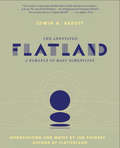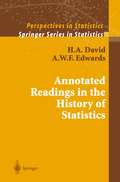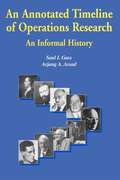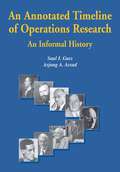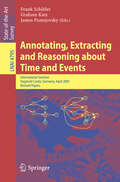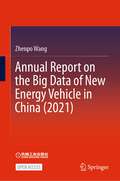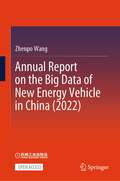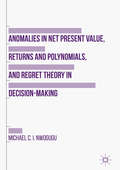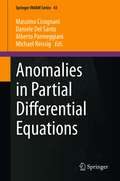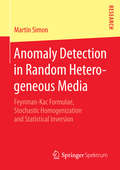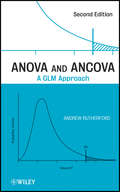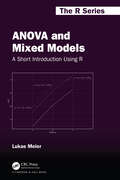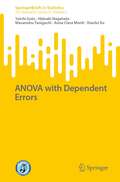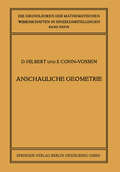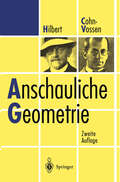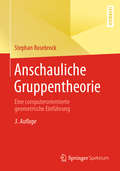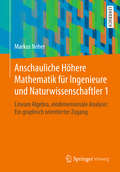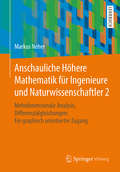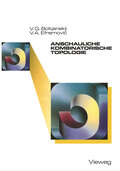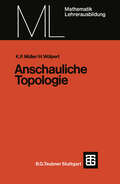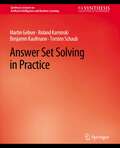- Table View
- List View
The Annotated Flatland: A Romance of Many Dimensions
by Ian StewartFlatland is a unique, delightful satire that has charmed readers for over a century. Published in 1884 by the English clergyman and headmaster Edwin A. Abbott, it is the fanciful tale of A. Square, a two-dimensional being who is whisked away by a mysterious visitor to The Land of Three Dimensions, an experience that forever alters his worldview.Like the original, Ian Stewart's commentary takes readers on a strange and wonderful journey. With clarity and wit, Stewart illuminates Abbott's numerous Victorian references and touches on such diverse topics as ancient Babylon, Karl Marx, Mary Shelley's Frankenstein, Mt. Everest, H.G. Wells, and phrenology. The Annotated Flatland makes fascinating connections between Flatland and Abbott's era, resulting in a classic to rival Abbott's own, and a book that will inspire and delight curious readers for generations to come.
The Annotated Flatland: A Romance of Many Dimensions
by Ian StewartFlatland is a unique, delightful satire that has charmed readers for over a century. Published in 1884 by the English clergyman and headmaster Edwin A. Abbott, it is the fanciful tale of A. Square, a two-dimensional being who is whisked away by a mysterious visitor to The Land of Three Dimensions, an experience that forever alters his worldview.Like the original, Ian Stewart's commentary takes readers on a strange and wonderful journey. With clarity and wit, Stewart illuminates Abbott's numerous Victorian references and touches on such diverse topics as ancient Babylon, Karl Marx, Mary Shelley's Frankenstein, Mt. Everest, H.G. Wells, and phrenology. The Annotated Flatland makes fascinating connections between Flatland and Abbott's era, resulting in a classic to rival Abbott's own, and a book that will inspire and delight curious readers for generations to come.
Annotated Readings in the History of Statistics (Springer Series in Statistics)
by H.A. David A.W.F. EdwardsThis book provides a selection of pioneering papers or extracts ranging from Pascal (1654) to R.A. Fisher (1930). The editors'annotations put the articles in perspective for the modern reader. A special feature of the book is the large number of translations, nearly all made by the authors. There are several reasons for studying the history of statistics: intrinsic interest in how the field of statistics developed, learning from often brilliant ideas and not reinventing the wheel, and livening up general courses in statistics by reference to important contributors.
An Annotated Timeline of Operations Research: An Informal History (International Series in Operations Research & Management Science #75)
by Saul I. Gass Arjang A. AssadAn Annotated Timeline of Operations Research: An Informal History recounts the evolution of Operations Research (OR) as a new science - the science of decision making. Arising from the urgent operational issues of World War II, the philosophy and methodology of OR has permeated the resolution of decision problems in business, industry, and government. The Timeline chronicles the history of OR in the form of self-contained, expository entries. Each entry presents a concise explanation of the events and people under discussion, and provides key sources where further relevant information can be obtained. In addition, books and papers that have influenced the development of OR or helped to educate the first generations of OR academics and practitioners are cited throughout the book. Starting in 1564 with seminal ideas that form the precursors of OR, the Timeline traces the key ideas and events of OR through 2004. The Timeline should interest anyone involved in OR -researchers, practitioners, academics, and, especially, students - who wish to learn how OR came into being. Further, the scope and expository style of the Timeline should make it of value to the general reader interested in the development of science and technology in the last half of the twentieth century.
An Annotated Timeline of Operations Research: An Informal History (International Series in Operations Research & Management Science #75)
by Saul I. Gass Arjang A. AssadAn Annotated Timeline of Operations Research: An Informal History recounts the evolution of Operations Research (OR) as a new science - the science of decision making. Arising from the urgent operational issues of World War II, the philosophy and methodology of OR has permeated the resolution of decision problems in business, industry, and government. The Timeline chronicles the history of OR in the form of self-contained, expository entries. Each entry presents a concise explanation of the events and people under discussion, and provides key sources where further relevant information can be obtained. In addition, books and papers that have influenced the development of OR or helped to educate the first generations of OR academics and practitioners are cited throughout the book. Starting in 1564 with seminal ideas that form the precursors of OR, the Timeline traces the key ideas and events of OR through 2004. The Timeline should interest anyone involved in OR -researchers, practitioners, academics, and, especially, students - who wish to learn how OR came into being. Further, the scope and expository style of the Timeline should make it of value to the general reader interested in the development of science and technology in the last half of the twentieth century.
Annotating, Extracting and Reasoning about Time and Events: International Seminar, Dagstuhl Castle, Germany, April 20-15, 2005, Revised Papers (Lecture Notes in Computer Science #4795)
by Frank Schilder Graham Katz James PustejovskyThis state-of-the-art survey comprises a selection of the material presented at the International Dagstuhl Seminar on Annotating, Extracting and Reasoning about Time and Events, held in Dagstuhl Castle, Germany, in April 2005. The seminar centered around an emerging de facto standard for time and event annotation: TimeML. It features nine papers that detail current research and discuss open problems concerning annotation, temporal reasoning, and event identification.
Annual Report on the Big Data of New Energy Vehicle in China (2021)
by Zhenpo WangThis open access book, based on static indicators and dynamic big data from local electric vehicles, is the first New-Energy Vehicles (NEVs) research report on the Big Data in China.Using the real-time big data collected by China's National Monitoring and Management Platform for NEVs, this book delves into the main annual technological progress of NEVs, the vehicle operating characteristics, it also anticipates the trend of NEVs industry.Various graphs&charts, detailed data this book offers will familiarize readers with the operation characteristics and practical application of China's NEVs industry and popularize the concept of automobile electrification. Besides, this book also makes an objective evaluation of the current situation and technological improvement of China's NEVs industry, presenting sensible suggestions for the development of the industry.This book is written for government staff, researchers, college staff, and technical staff of automobile and spare parts enterprises, which serves as an important reference for the decision-making of government departments and strategic decisions of automotive companies.
Annual Report on the Big Data of New Energy Vehicle in China (2022)
by Zhenpo WangThis is an Open Access book. This book based on static indicators and dynamic big data from local electric vehicles, is the first New-Energy Vehicles (NEVs) research report on the Big Data in China. Using the real-time big data collected by China's National Monitoring and Management Platform for NEVs, this book delves into the main annual technological progress of NEVs, the vehicle operating characteristics, it also anticipates the trend of NEVs industry.Various graphs & charts, detailed data this book offers will familiarize readers with the operation characteristics and practical application of China's NEVs industry and popularize the concept of automobile electrification. Besides, this book also makes an objective evaluation of the current situation and technological improvement of China's NEVs industry, presenting sensible suggestions for the development of the industry.This book is written for government staff, researchers, college staff, and technical staff of automobile and spare parts enterprises, which serves as an important reference for the decision-making of government departments and strategic decisions of automotive companies.
Anomalies in Net Present Value, Returns and Polynomials, and Regret Theory in Decision-Making
by Michael C. NwoguguThis book explores why Modified Internal Rate of Return (MIRR) and Net Present Value (NPV) are not necessarily accurate or efficient tools for valuation and decision-making. The author specifically addresses the biases and framing effects inherent in the NPV/MIRR/IRR model and in related approaches such as Adjusted Present Value (APV), Net Future Value (NFV), and by extension, Polynomials. In doing so, the book presents new ways of solving higher order polynomials using invariants and homomorphisms and explains why the “Fundamental Theorem of Algebra”, the Binomial Theorem and the “Descartes Sign Rule” are unreliable. Chapters also discuss how International Asset Pricing Theory (IAPT) and Intertemporal Capital Asset Pricing Models (ICAPM) can produce inaccurate results in certain circumstances. The conditions under which ICAPM and IAPT may be accurate are described; as well as why those conditions cannot, or are unlikely to, exist. The conditions under which negative interest rates may exist or are justified are also outlined. Moreover, the author explains why traditional Consumption-Savings-Investment-Production models of allocation can be inefficient, and then introduces a new model of allocation that can be applied to individuals, households and companies. Finally, the book explains why the Elasticity of Intertemporal Substitution is a flawed concept and introduces the Marginal Rate of Intertemporal Joint Substitution as a solution.
Anomalies in Partial Differential Equations (Springer INdAM Series #43)
by Massimo Cicognani Daniele Del Santo Alberto Parmeggiani Michael ReissigThe contributions contained in the volume, written by leading experts in their respective fields, are expanded versions of talks given at the INDAM Workshop "Anomalies in Partial Differential Equations" held in September 2019 at the Istituto Nazionale di Alta Matematica, Dipartimento di Matematica "Guido Castelnuovo", Università di Roma "La Sapienza". The volume contains results for well-posedness and local solvability for linear models with low regular coefficients. Moreover, nonlinear dispersive models (damped waves, p-evolution models) are discussed from the point of view of critical exponents, blow-up phenomena or decay estimates for Sobolev solutions. Some contributions are devoted to models from applications as traffic flows, Einstein-Euler systems or stochastic PDEs as well. Finally, several contributions from Harmonic and Time-Frequency Analysis, in which the authors are interested in the action of localizing operators or the description of wave front sets, complete the volume.
Anomaly Detection in Random Heterogeneous Media: Feynman-Kac Formulae, Stochastic Homogenization and Statistical Inversion
by Martin SimonThis monograph is concerned with the analysis and numerical solution of a stochastic inverse anomaly detection problem in electrical impedance tomography (EIT). Martin Simon studies the problem of detecting a parameterized anomaly in an isotropic, stationary and ergodic conductivity random field whose realizations are rapidly oscillating. For this purpose, he derives Feynman-Kac formulae to rigorously justify stochastic homogenization in the case of the underlying stochastic boundary value problem. The author combines techniques from the theory of partial differential equations and functional analysis with probabilistic ideas, paving the way to new mathematical theorems which may be fruitfully used in the treatment of the problem at hand. Moreover, the author proposes an efficient numerical method in the framework of Bayesian inversion for the practical solution of the stochastic inverse anomaly detection problem.
ANOVA and ANCOVA: A GLM Approach (Introducing Statistical Methods Ser.)
by Andrew RutherfordProvides an in-depth treatment of ANOVA and ANCOVA techniques from a linear model perspective ANOVA and ANCOVA: A GLM Approach provides a contemporary look at the general linear model (GLM) approach to the analysis of variance (ANOVA) of one- and two-factor psychological experiments. With its organized and comprehensive presentation, the book successfully guides readers through conventional statistical concepts and how to interpret them in GLM terms, treating the main single- and multi-factor designs as they relate to ANOVA and ANCOVA. The book begins with a brief history of the separate development of ANOVA and regression analyses, and then goes on to demonstrate how both analyses are incorporated into the understanding of GLMs. This new edition now explains specific and multiple comparisons of experimental conditions before and after the Omnibus ANOVA, and describes the estimation of effect sizes and power analyses leading to the determination of appropriate sample sizes for experiments to be conducted. Topics that have been expanded upon and added include: Discussion of optimal experimental designs Different approaches to carrying out the simple effect analyses and pairwise comparisons with a focus on related and repeated measure analyses The issue of inflated Type 1 error due to multiple hypotheses testing Worked examples of Shaffer's R test, which accommodates logical relations amongst hypotheses ANOVA and ANCOVA: A GLM Approach, Second Edition is an excellent book for courses on linear modeling at the graduate level. It is also a suitable reference for researchers and practitioners in the fields of psychology and the biomedical and social sciences.
ANOVA and ANCOVA: A GLM Approach
by Andrew RutherfordProvides an in-depth treatment of ANOVA and ANCOVA techniques from a linear model perspective ANOVA and ANCOVA: A GLM Approach provides a contemporary look at the general linear model (GLM) approach to the analysis of variance (ANOVA) of one- and two-factor psychological experiments. With its organized and comprehensive presentation, the book successfully guides readers through conventional statistical concepts and how to interpret them in GLM terms, treating the main single- and multi-factor designs as they relate to ANOVA and ANCOVA. The book begins with a brief history of the separate development of ANOVA and regression analyses, and then goes on to demonstrate how both analyses are incorporated into the understanding of GLMs. This new edition now explains specific and multiple comparisons of experimental conditions before and after the Omnibus ANOVA, and describes the estimation of effect sizes and power analyses leading to the determination of appropriate sample sizes for experiments to be conducted. Topics that have been expanded upon and added include: Discussion of optimal experimental designs Different approaches to carrying out the simple effect analyses and pairwise comparisons with a focus on related and repeated measure analyses The issue of inflated Type 1 error due to multiple hypotheses testing Worked examples of Shaffer's R test, which accommodates logical relations amongst hypotheses ANOVA and ANCOVA: A GLM Approach, Second Edition is an excellent book for courses on linear modeling at the graduate level. It is also a suitable reference for researchers and practitioners in the fields of psychology and the biomedical and social sciences.
ANOVA and Mixed Models: A Short Introduction Using R (Chapman & Hall/CRC The R Series)
by Lukas MeierANOVA and Mixed Models: A Short Introduction Using R provides both the practitioner and researcher a compact introduction to the analysis of data from the most popular experimental designs. Based on knowledge from an introductory course on probability and statistics, the theoretical foundations of the most important models are introduced. The focus is on an intuitive understanding of the theory, common pitfalls in practice, and the application of the methods in R. From data visualization and model fitting, up to the interpretation of the corresponding output, the whole workflow is presented using R. The book does not only cover standard ANOVA models, but also models for more advanced designs and mixed models, which are common in many practical applications. Features Accessible to readers with a basic background in probability and statistics Covers fundamental concepts of experimental design and cause-effect relationships Introduces classical ANOVA models, including contrasts and multiple testing Provides an example-based introduction to mixed models Features basic concepts of split-plot and incomplete block designs R code available for all steps Supplementary website with additional resources and updates available at https://stat.ethz.ch/~meier/teaching/book-anova/ This book is primarily aimed at students, researchers, and practitioners from all areas who wish to analyze corresponding data with R. Readers will learn a broad array of models hand-in-hand with R, including the applications of some of the most important add-on packages.
ANOVA and Mixed Models: A Short Introduction Using R (Chapman & Hall/CRC The R Series)
by Lukas MeierANOVA and Mixed Models: A Short Introduction Using R provides both the practitioner and researcher a compact introduction to the analysis of data from the most popular experimental designs. Based on knowledge from an introductory course on probability and statistics, the theoretical foundations of the most important models are introduced. The focus is on an intuitive understanding of the theory, common pitfalls in practice, and the application of the methods in R. From data visualization and model fitting, up to the interpretation of the corresponding output, the whole workflow is presented using R. The book does not only cover standard ANOVA models, but also models for more advanced designs and mixed models, which are common in many practical applications. Features Accessible to readers with a basic background in probability and statistics Covers fundamental concepts of experimental design and cause-effect relationships Introduces classical ANOVA models, including contrasts and multiple testing Provides an example-based introduction to mixed models Features basic concepts of split-plot and incomplete block designs R code available for all steps Supplementary website with additional resources and updates available at https://stat.ethz.ch/~meier/teaching/book-anova/ This book is primarily aimed at students, researchers, and practitioners from all areas who wish to analyze corresponding data with R. Readers will learn a broad array of models hand-in-hand with R, including the applications of some of the most important add-on packages.
ANOVA with Dependent Errors (SpringerBriefs in Statistics)
by Yuichi Goto Hideaki Nagahata Masanobu Taniguchi Anna Clara Monti Xiaofei XuThis book presents the latest results related to one- and two-way models for time series data. Analysis of variance (ANOVA) is a classical statistical method for IID data proposed by R.A. Fisher to investigate factors and interactions of phenomena. In contrast, the methods developed in this book apply to time series data. Testing theory of the homogeneity of groups is presented under a wide variety of situations including uncorrelated and correlated groups, fixed and random effects, multi- and high-dimension, parametric and nonparametric spectral densities. These methods have applications in several scientific fields. A test for the existence of interactions is also proposed. The book deals with asymptotics when the number of groups is fixed and sample size diverges. This framework distinguishes the approach of the book from panel data and longitudinal analyses, which mostly deal with cases in which the number of groups is large. The usefulness of the theory in this book is illustrated by numerical simulation and real data analysis. This book is suitable for theoretical statisticians and economists as well as psychologists and data analysts.
Anschauen, Anfassen, Auffassen.: Eine Wissensgeschichte Mathematischer Modelle (Mathematik im Kontext)
by Anja SattelmacherDas Herstellen, Sammeln und Verbreiten mathematischer Modelle war im 19. und frühen 20. Jahrhundert weit verbreitete Praxis an Universitäten und technischen Hochschulen.Anhand ausgewählter Modelle im Kontext ihrer Sammlungen lässt sich zeigen, dass das Wissen über mathematische Modelle im Prozess der Modellierung, des Sammelns, des Veräußerns und des Ausstellens generiert wurde. Dabei flossen sowohl künstlerische Praktiken als auch reformpädagogische Überlegungen in dieses Wissen mit ein. Im Zentrum der Studie stehen Mathematikprofessoren, die die Verwendung von Modellen im Kontext der akademischen Lehre auf unterschiedliche Weise vorantrieben. Weniger bekannt ist hingegen, dass auch Frauen einen wichtigen Anteil an der Produktion von Modellen hatten. Das Buch leistet mit den Auswertungen zahlreicher Quellen aus unterschiedlichen Archiven sowie einer ethnographischen Beobachtung eines Modellbauers einen wichtigen Beitrag für eine praxeologisch orientierte Wissenschaftsgeschichte.
Anschauliche Geometrie (Grundlehren der mathematischen Wissenschaften #37)
by David Hilbert Stefan Cohn-VossenDieser Buchtitel ist Teil des Digitalisierungsprojekts Springer Book Archives mit Publikationen, die seit den Anfängen des Verlags von 1842 erschienen sind. Der Verlag stellt mit diesem Archiv Quellen für die historische wie auch die disziplingeschichtliche Forschung zur Verfügung, die jeweils im historischen Kontext betrachtet werden müssen. Dieser Titel erschien in der Zeit vor 1945 und wird daher in seiner zeittypischen politisch-ideologischen Ausrichtung vom Verlag nicht beworben.
Anschauliche Geometrie
by David Hilbert Stephan Cohn-Vossen1932 erstmals erschienen, hat der Klassiker der Geometrie bis heute nichts von seiner Frische und Kraft eingebüßt. Die weltbekannten Autoren stellen in dem Band zugrundeliegende Leitmotive und verblüffende Zusammenhänge in der Geometrie verständlich dar. David Hilbert, dessen Ziel es war, die Faszination der Geometrie zu vermitteln, schrieb im Vorwort: „Das Buch soll dazu dienen, die Freude an der Mathematik zu mehren, indem es dem Leser erleichtert, in das Wesen der Mathematik einzudringen, ohne sich einem beschwerlichen Studium zu unterziehen".
Anschauliche Gruppentheorie: Eine computerorientierte geometrische Einführung
by Stephan RosebrockMan kann Gruppen als algebraische Objekte auffassen, die die Symmetrie von geometrischen Objekten beschreiben. Dieser Blickwinkel steht bei dem Buch im Vordergrund und somit geht es in dem Buch auch um Geometrie. Gruppen drücken Symmetriephänomene algebraisch aus, man rechnet mit Spiegelungen, Drehungen usw., allgemein mit Abbildungen von Räumen auf sich. Das Buch kann vorlesungsbegleitend bei Algebra- und Gruppentheorie-Vorlesungen eingesetzt werden. Es eignet sich auch besonders gut für Lehramtsstudierende, da es den Stoff computerorientiert (unter Benutzung des frei erhältlichen Gruppentheorie-Programms GAP) mit vielen anschaulichen Beispielen präsentiert. Für die 2. Auflage wurden einige Teile des Buches ausführlicher dargestellt. Einige Inhalte (zum Beispiel die Klassifikation der endlichen Gruppen bis zur Ordnung 11) wurden hinzugefügt und Fehler korrigiert.
Anschauliche Höhere Mathematik für Ingenieure und Naturwissenschaftler 1: Lineare Algebra, eindimensionale Analysis: Ein graphisch orientierter Zugang
by Markus NeherDas Buch bietet eine anschauliche und sorgfältige Einführung in die Höhere Mathematik mit didaktisch gut durchdachtem Aufbau, bei dem nahezu alle Sachverhalte aus den zuvor behandelten Inhalten hergeleitet und begründet werden. Die hierarchische Gliederung unterstützt das vernetzte Lernen, das für eine sichere und langfristige Beherrschung des Stoffs unerlässlich ist. Band 1 behandelt Lineare Algebra sowie Differenzial- und Integralrechnung einer Veränderlichen, einschließlich einiger numerischer Themen.Die vielen professionell gestalteten Graphiken tragen zum Verständnis ebenso bei wie die vollständig gerechneten Beispiele. Ein wertvoller Begleiter für alle Studierenden in ingenieur- und naturwissenschaftlichen Studiengängen. Studierenden in Mathematikstudiengängen, insbesondere im Lehramt, kann das Buch als anschauliche Einführung in die Differenzial- und Integralrechnung einer und mehrerer Veränderlicher dienen.
Anschauliche Höhere Mathematik für Ingenieure und Naturwissenschaftler 2: Mehrdimensionale Analysis, Differenzialgleichungen: Ein graphisch orientierter Zugang
by Markus NeherDas Buch bietet eine anschauliche und sorgfältige Einführung in die Höhere Mathematik mit didaktisch gut durchdachtem Aufbau, bei dem nahezu alle Sachverhalte aus den zuvor behandelten Inhalten hergeleitet und begründet werden. Die hierarchische Gliederung unterstützt das vernetzte Lernen, das für eine sichere und langfristige Beherrschung des Stoffs unerlässlich ist. Band 2 behandelt Differenzial- und Integralrechnung mehrerer Veränderlicher, Vektoranalysis und gewöhnliche Differenzialgleichungen, einschließlich numerischer Verfahren und eines Ausblicks auf partielle Differenzialgleichungen.Die vielen professionell gestalteten Graphiken tragen zum Verständnis ebenso bei wie die vollständig gerechneten Beispiele. Ein wertvoller Begleiter für alle Studierenden in ingenieur- und naturwissenschaftlichen Studiengängen. Studierenden in Mathematikstudiengängen, insbesondere im Lehramt, kann das Buch als anschauliche Einführung in die Differenzial- und Integralrechnung einer und mehrerer Veränderlicher dienen.
Anschauliche Topologie: Eine Einführung die elementare Topologie und Graphentheorie (Mathematik für die Lehrerausbildung)
by Kurt Peter Müller Heinrich WölpertAnswer Set Solving in Practice (Synthesis Lectures on Artificial Intelligence and Machine Learning)
by Martin Liu Roland RoijersAnswer Set Programming (ASP) is a declarative problem solving approach, initially tailored to modeling problems in the area of Knowledge Representation and Reasoning (KRR). More recently, its attractive combination of a rich yet simple modeling language with high-performance solving capacities has sparked interest in many other areas even beyond KRR. This book presents a practical introduction to ASP, aiming at using ASP languages and systems for solving application problems. Starting from the essential formal foundations, it introduces ASP's solving technology, modeling language and methodology, while illustrating the overall solving process by practical examples. Table of Contents: List of Figures / List of Tables / Motivation / Introduction / Basic modeling / Grounding / Characterizations / Solving / Systems / Advanced modeling / Conclusions
